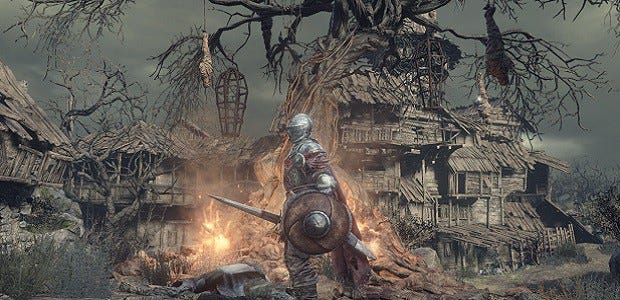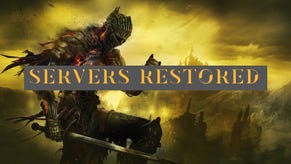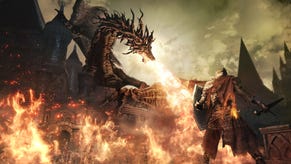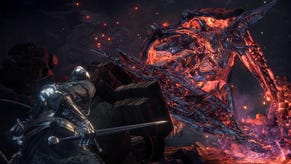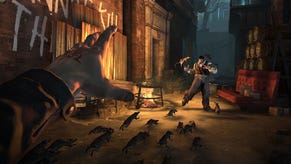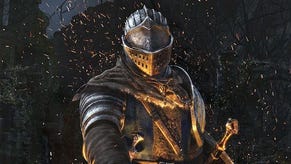Wot I Think: Dark Souls III
Bonfire Knight
Dark Souls III [official site] is almost here so if you haven't done so already, prepare to die. In this spoiler-free review, I'll explain how From Software's latest borrows almost as much from trilogy predecessor Demon's Souls as from the previous two games, and why I might be ready to say goodbye to the series, even though I've loved almost every minute of my time in Lothric.
In the moments when I’m feeling generous toward Dark Souls III, I’m tempted to say it takes the best of series-opener (and only non-PC entry) Demon’s Souls and mixes it with the best of Dark Souls I. That’s an argument I reckon I could stitch together.
There have been plenty of those moments, scattered across the tens of hours I’ve already spent with From Software’s latest, but there have been plenty of drawn out moments when I’ve felt as if both I and the series are going through the motions to an extent. To explain why that is, I need to talk about the aspects of the Souls games that I love.
I don't love difficult games. It's important to get that out of the way. There are difficult games that I love but I don't love them because they're difficult - that's a side effect of their design. In the case of the Souls series, the most important fact is not that you die but that you come back to life and try again. Keep that in mind.
What I do enjoy, somewhat on the masochistic side, is feeling lost and trapped. Dark Souls does dungeons better than any RPG I’ve ever played, making them both part of the landscape in a way that feels both natural and unnerving, and making them absolutely terrifying. They are shadow and despair, places that will literally sap the souls out of you and leave you alone in the dark without a hope in the world.
For the most part, Dark Souls III forgoes that feeling, opting for broader spaces.
I also enjoy the sense of being in a world made up of layers that can be peeled back and punctured, revealing unexpected connections and pathways. That aspect of the series hasn’t been lost here but it has been weirdly fragmented.
As much as any of the world-building and design, I love the combat. Thankfully, Dark Souls III might be the pinnacle of the series in that regard. The speed and weight of the player character feels just right and the new skills that are attached to weapon types lend extra style and variety to combat. I found most abilities more useful against crowds of normal enemies - and they come in greater numbers than ever before - than against bosses, but I expect the utility of the secondary skills will vary from class to class.
I’ve already expressed my dislike of some creature designs in the early stages of the game and I’m happy to say I found the latter stages the most enjoyable both from a challenge and an aesthetic perspective. It’s a beautiful game throughout though, despite some lapses, and the best looking in the series by far. Even though the level design feels like it flits between themes at times, rather than extending on the expression of a single theme or concept, each area has something to offer visually. The Souls games have always done scale well, with their imposing boss creatures and distant castles that pierce the earth and the sky, but there are larger arenas now.
More room to maneuver means more room for weird monsters to dash, roll and pounce. For the first time in a Souls game, I needed space to breathe mid-combat and was able to find it. Sometimes that involved fleeing from slow-moving but ferocious opponents outside a boss arena, and sometimes it involved exploiting the patterns of a boss’ behaviour to recover health and equilibrium at the far side of a vast space. In the former case, ‘activating’ enemies and then forging ahead without killing them led to some excellent moments of terror when creatures managed to stalk me through an entire level.
That didn’t happen often though because usually, I kill everything that moves. And I kill it over and over again. Repetition, frustration and eventual catharsis. That’s the heart of the game. You’ll see every area of a Dark Souls game so many times on your first playthrough that any weaknesses or inconsistencies have nowhere to hide. They’re games that demand scrutiny and attention in a way that makes everyone who plays them a critic. Flaws are exposed.
Dark Souls III’s flaws aren’t as obvious or as damaging as those in its immediate predecessor. Placement of enemies, level design and combat are all finely crafted, and even the portions that I’ve played again and again and again, through a combination of DYING and retrying early areas with various character builds, hold up to close examination.
The game hits you with combinations. Not in the sense that there are flurries of attacks from a single enemy, although that is true as well, but in the sense that the layout of an area and the placement of the enemies within it form a sequence of events. Many of these sequences are brilliant, pulling off Edge of Tomorrow/Live.Die.Repeat’s gimmick of placing the protagonist in the role of omniscient mastermind and empowering you in a way that plays against the series’ notoriety as a mechanism for misery and masochism.
In defiance of that reductive labelling - which plays into the idea that Dark Souls is interesting only for its difficulty and that it is in fact defined by its difficulty - I can confirm that I’ve felt like a complete badass for hours at a time while playing. Walking through a village, slashing, backstabbing and hurling bombs, knowing where your targets are before they’ve even had a chance to react to your presence - that’s the kind of power trip that the Souls recipe of perfection through repetition permits. It’s not for everyone but for those who have drank the Estus, it’s one of the most potent elixirs in gaming.
And while I’m hesitant to suggest this might be the Souls game to win over a few non-believers, particularly given that it’s the fifth in the series by some counts (PS4-exclusive Bloodborne is a very close sibling), there are aspects of III that might frustrate long-time fans while making the game slightly more palatable for those who have struggled to find a foothold in previous entries.
Most of my concerns relate to the bonfires. Central to both the lore and the mechanics of the series, bonfires allow you to cash in your winnings to upgrade equipment and stats, and in this entry they’re also used to teleport between areas and back to the Firelink Shrine, the central hub wherein you can buy equipment, upgrade gear and level up your character.
Having all expenditure of souls take place in a discrete part of the world, disconnected from events elsewhere, provides a sanctuary and I quite like the idea of this one safe place in a world gone to hell and ruin. But it also means extra loading screens whenever you want to take care of business (short loading screens, mind) and emphasises the fragmented nature of this world. There are wonderful places to explore in Dark Souls III and they’re all linked in imaginative and spectacular ways but those links are visual rather than physical. They are within the same continuous world and there is a logic to your progression through them, but the entire setting is not one wondrous physical labyrinth.
In short, Dark Souls III contains some superbly designed levels but Dark Souls I, as a whole, might be my favourite level of all time.
And that goes back to the bonfires. They’re entrances and exits as well as checkpoints, and they’re not particularly sparsely placed. All of that combines to eliminate one of my favourite aspects of Dark Souls I - and it’s a feature that the first sequel also lacked - and that’s the fear of becoming lost in some place that would have been best left forgotten. Even on the rare occasion you do descend into depths, they’re relatively shallow depths, and the game’s broader structure doesn’t allow for the possibility of becoming trapped, burning life after life in an attempt to escape some claustrophobic dead-end. You’re never far from safety.
That’s not to say Dark Souls III will wrap you in cotton wool, but I’ve found it the easiest in the series. The pinch of salt that you should take with that particular statement relates to the fact that I’ve played these games a lot so experience may have been a factor, but I think the slightly faster pace of combat and the presence of more but feebler enemies in many areas is a factor as well. On top of that, the character I’ve played with most - a mercenary with either dual-wielded super-powered swords or a single sword and shield - turned out to have the ideal skillset for many of the bosses. There’s a certain type of boss creature that crops up several times and I took the same approach in each instance. Worked every time.
It’s not as gruelling a game as the previous two - and gruelling would be a complimentary term here - but I do think it’s an improvement on the second. That’s partly because the combat is better than it’s ever been but it’s also down to the design of the individual areas. They’re more imaginative, in a structural sense, even if they’re sometimes a disappointment thematically and visually.
One of the better areas in the game, in terms of its twists and turns, looks like a missing chapter from The Evil Within. There’s a consistent crossing of the line between dark fantasy horror and giblets-and-goo horror, and the latter is never as interesting to me as the surreal jagged edges of the faded worlds in the previous games.
To be clear, the majority of everything worked for me but there is a lack of cohesion.
I’ve said before that Dark Souls II, without Miyazaki at the helm, felt like a cover version. Dark Souls III feels like a remix. There are areas that quote previous entries in the series, treating them as jazz standards to be reinterpreted and reshaped, and there are moments of deja vu. It’s an energetic remix but some of the flow and rhythm has been lost.
With all of that said, there have been few games over the last twelve months that I’ve enjoyed more, and I’m already planning my next playthrough. The lightness of the combat and the variety of weapons and abilities available make experimentation extremely tempting, and the changes to Estus use (flasks can be upgraded and Estus levels split between abilities and health) allow for more flexibility than ever. I want to try a ranged and spellcasting build next, mostly because those are skills I rarely explore at all.
There are so many joys still to discover, and I’ve been careful not to spoil the ones that I have discovered. Secret areas, puzzling connections between games, covenants to join and shrines to unearth. This is a very healthy and dense game.
It’s not a strange game though. Not anymore, with its predecessors casting such long shadows. While refined in some areas and oddly conservative in others, Dark Souls III is, above all, a Dark Souls game. I was often delighted but I was very rarely surprised.
Technically, I had some framerate drops when first entering an area with lots of foliage detail and expansive views, but they only lasted for a few seconds while my graphics card found its feet. There are no cursed areas, with consistently bad framerates, as in the port of the first game, and my biggest disappointment is that From didn’t make more use of lighting effects.
Having somewhat fluffed their lines with Dark Souls II, which was originally shown to have much greater contrasts between dark indoor areas and bright outdoor settings, there was a perfect chance to deliver the perfect soliloquy here. But, again, torches are useless because not even the dankest dungeons are ever all that dark. A shame.
Oh, and that’s another criticism, so let me reiterate that I’m extremely glad to have played Dark Souls III and will certainly be making time to play it again, but I’m not sure I’d be entirely keen on another similar adventure anytime soon. More of a good thing is always welcome but I think the law of diminishing returns may be kicking in, for me at least. I’d love to hear Miyazaki and From’s next big concept album rather than another set of remixes.
If this were to be the final Souls game, I’d be happy to say goodbye. It’s not quite the crowning achievement of the series but it’s a fantastically inventive and fluid interpretation of the formula. And perhaps that would make it a great first Souls game for somebody new to the series as well.
My complaints are minor, given the quality of the game as a whole, and some of them are directed toward elements that make this entry more approachable than its predecessors. Just remember, if you are going to play, not even the biggest and most brutal beasts are as tough as you imagine when you first see them, and the next bonfire is rarely more than a few minutes away.
Dark Souls III is available April 11th for Windows. We'll have an in-depth look at multiplayer once we've had a chance to play on public servers, and other coverage to come.
